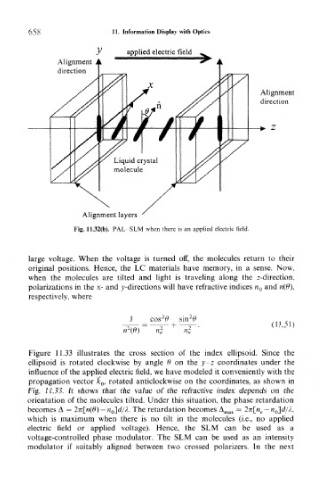Page 674 - Introduction to Information Optics
P. 674
658 11. Information Display with Optics
applied electric field
Alignment
direction
Alignment
direction
Alignment layers
Fig. 11.32(b). PAL SLM when there is an applied electric field.
large voltage. When the voltage is turned off, the molecules return to their
original positions. Hence, the LC materials have memory, in a sense. Now,
when the molecules are tilted and light is traveling along the z-direction,
polarizations in the x- and ^-directions will have refractive indices n 0 and n(0),
respectively, where
2
1 sin 0
"^r (11.51)
Figure 11.33 illustrates the cross section of the index ellipsoid. Since the
ellipsoid is rotated clockwise by angle 8 on the y-z coordinates under the
influence of the applied electric field, we have modeled it conveniently with the
propagation vector k 0, rotated anticlockwise on the coordinates, as shown in
Fig. 11.33. It shows that the value of the refractive index depends on the
orientation of the molecules tilted. Under this situation, the phase retardation
becomes A = 2n[n(6) — n 0]d/A. The retardation becomes A max = 2n\ji e-~ n^djA,
which is maximum when there is no tilt in the molecules (i.e., no applied
electric field or applied voltage). Hence, the SLM can be used as a
voltage-controlled phase modulator. The SLM can be used as an intensity
modulator if suitably aligned between two crossed polarizers. In the next

